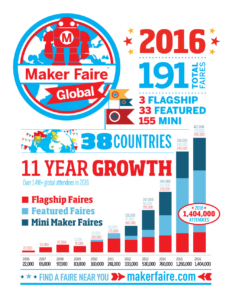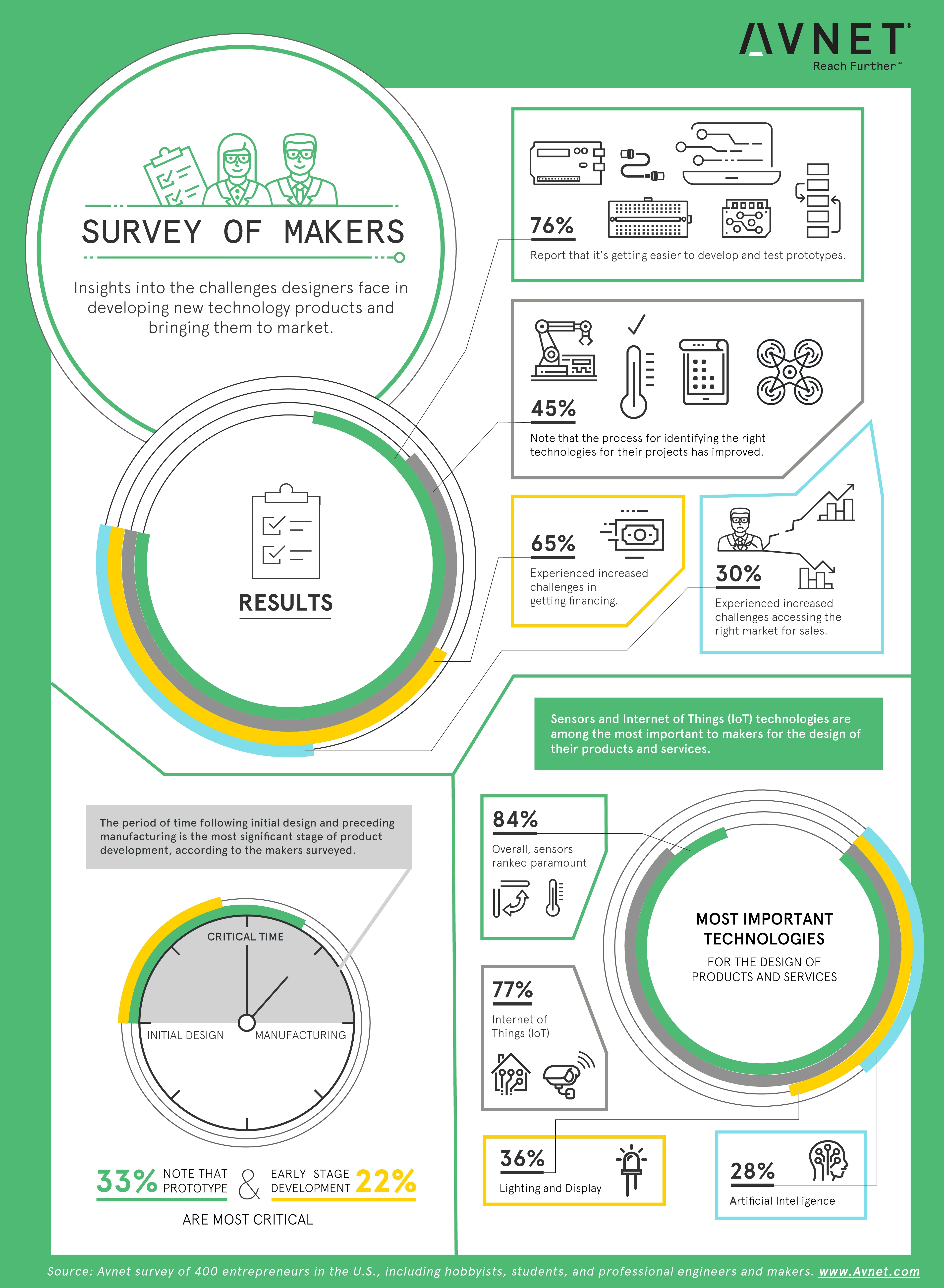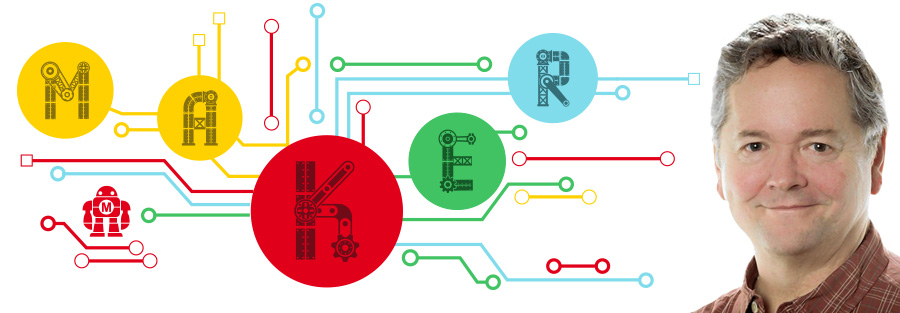Dale Dougherty, Founder & CEO, Maker Media
SCN: Tell us how you went from an English major at University of Louisville to the “Father of the Maker Movement?”
DD: That’s a good question. I think to some degree the paths we take in our lives are always kind of amazing in retrospect. My path has been driven largely by my unending interest in learning – about what is going on in the world, what people are interested in and what needs to be done. For example, when I built the first commercial web site (GNN) in 1993, I got involved just by observing that there was this group of enthusiastic people, trying to make a difference. The genesis of the term “maker” and the more formal connection of these people through MAKE magazine and the Maker Faires were similar. I saw that there were these people who were generally outside of the traditional, established commercial sector, whose talents and contributions – in terms of what they do, how they learn and the different ideas they have about what is important and meaningful – were not being valued as much as I felt they should be. Through Maker Media and the Maker Faires, we have provided a vehicle for these innovators to network, share their ideas and tap into the collective resources of the maker community. (Editor’s Note: Makers are responding to these opportunities with phenomenal zeal. In 2016, 1.4 million individuals attended one of the 191 Maker Faires held throughout 38 countries worldwide.)
SCN: How has the perception of the maker movement and its participants evolved since you first launched MAKE magazine in 2005?
DD: I would say that today there is a better understanding within traditional business sectors in terms of what the maker movement is really all about and the role these individuals can play in building an innovation ecosystem that can benefit everyone – makers, corporate, consumers.
But, there are still those that dismiss the community as just a bunch of tinkerers or hobbyists, etc. and my response to them is yes, they are that, but they can also be so much more. For many of the corporate executives I have met, their perspective changes once they realize how many makers they have within their own organizations, and not just in new product development. Once this reality is acknowledged, then corporate executives better understand that the “movement” and its people are not just these wacky, fringe outsiders, but they are everyday people, with a great deal of curiosity and enthusiasm. True, they may not fall into the typical corporate cookie-cutter model, but how many companies really want a totally homogenous workforce?
“There are still those that dismiss the community as just a bunch of tinkerers or hobbyists, etc. and my response to them is yes, they are that, but they can also be so much more.”
SCN: Through the application of advance manufacturing technologies, like 3D printing, makers have been credited with driving consumer demand for more personalized, quick-turn product. How might this impact the way larger-scale manufacturers approach new product development?
DD: In some ways, I think the maker movement makes us look at all products and devices as a collection of components that we can customize – like the automotive aftermarket. But, I wouldn’t say that consumers’ growing expectation for more custom, personalized product is entirely a byproduct of the maker movement. Advances in software have played a big role as well. People get so used to things being able to change on the fly, they have come to expect that same flexibility with their hardware.
From a technology standpoint, we are seeing a rapid advancement in the industrialization of 3D printing/additive manufacturing because of the maker movement. Though 3D printing technology goes back to 1980s, as an industry it remained very limited in its use, due in large part to the prohibitive price points. When makers took an interest in the technology, they created market demand that drove competition and brought the cost down significantly.
This is a prime example of one of the great benefits of hobbyists and tinkerers, etc. I think many makers didn’t even really know what they wanted to do with 3D printing; they just wanted to get it and then figure it out. They were willing to invest the time and energy into learning how to best utilize the technology. As a result of their “playing” with these technologies, both consumers and manufacturers now think differently about how things can be made. We are now at a place where even the average consumer can conceive of a time when they might, for example, print their own sneakers at home.
Source: MAKE Magazine https://makezine.com/2017/03/07/nolan-bushnell/
SCN: Does this customization expectation make it harder for an OEM to build brand loyalty?
DD: Actually, I think just the opposite is true. When a consumer has the ability to customize a product, it changes their relationship with that object – it becomes uniquely “theirs.” That is a very positive thing that can inspire greater brand loyalty because, in a sense, the manufacturer is providing a product that enables the consumer and that is important. On the other hand, if a manufacturer tries to deny the user the opportunity to perform modifications, the customer is likely to feel as though that company is less concerned with the user experience than they are with their own goals. And that is most definitely not the kind of relationship that breeds loyalty.
SCN: What do you think is the maker’s greatest asset?
DD: Hands down it is passion. The value you create as a company comes from the passion you can inspire in your customers. Makers connect more easily with that customer passion because their focus is not just in acquiring customers, but also in building communities that share common interests and goals. That is something makers have been really good at from the start. So, customers can be a part of the development ecosystem. They can share code, recommend features the developer may not have even considered, etc. It’s a very different world when you are driven by a love of technology and problem solving, as opposed to simply being in it for the money. Most companies start with that kind of aspiration, but lose the focus as they grow. I think that this is where many larger companies come up short. They can be tone deaf to listening and interacting with their “community.”
“It’s a very different world when you are driven by a love of technology and problem solving, as opposed to simply being in it for the money.”
SCN: Over the past several years, supply chain management has become a significant competitive differentiator for established manufacturers. Do you see that same dynamic eventually translating into the maker space?
DD: Absolutely. It is important for makers to think about sourcing and logistics and all those considerations much earlier in the process than they typically do today. Many makers are still novices when it comes to business and operations management. So, when they are putting together their BOMs and looking for sources, they often just consider price, without understanding the different levels of support that may be available at each price point and the potential strategic advantages of getting to market quicker, more cost effectively and with product that is likely to be higher quality and more reliable.
Unfortunately, the risk associated with this sourcing inexperience does go beyond inefficiency. They may not be aware of the potential pitfalls of buying from an online only resource or a site that aggregates supply from thousands of sources. Many learn the hard way that if you don’t carefully vet your sources, you could end up with parts that are counterfeit, unreliable or even entirely nonfunctional.
 SCN: What are some of the ways in which the makers’ approach to sourcing differs from traditional corporate procurement?
SCN: What are some of the ways in which the makers’ approach to sourcing differs from traditional corporate procurement?
DD: When in prototyping phases, they tend to just be interested in what is readily available to them, they aren’t as concerned with it being the “perfect” part or even the best price because they are not buying a lot of them, they are just looking to determine if their idea can work. So, at this point, availability is most important to them. It is less critical for these individuals to have a source of supply that can offer them 100 different accelerometers than it is for them to have someone who has four or five they can get quickly and affordably.
Another piece, that the traditional supply chain/procurement folks may not be as familiar with, is that some of the sourcing decisions – why I use an Arduino vs. some other technology – may be because I know that there is this extensive support community online that I can tap into when I have a problem. Having that community and the confidence that they can get the help they need without having to rely on the manufacturer directly is really valuable to these people when they are trying to figure something out.
SCN: OK, so, we have this community of innovators, and a population of corporations that need more innovation, how do we bring them together?
DD: First of all, it has to be a two-way process – if everyone just does their own thing, then nothing really gets accomplished. The key then is for companies to train people to be good at collaborating and working together – even among different stakeholders within and outside the company. It can be hard for many companies to be open to, and trust, ideas coming from outside of their organization, but the maker community offers a deep well of inspiration and innovation that companies can benefit from if they open themselves up and focus on how they can foster those ideas and develop them and provide resources that may help scale those ideas.
On example of a company that has done a great job embracing the maker community is GE. As entrenched in their 100+ year history as the company has been, GE has really embraced the concept of crowdsourcing with programs like First Build. For example, GE was considering adding a USB port to a line of clothes dryers. They asked a group of makers, “If we put a USB port on a dryer, what kinds of things would you do with it?” The feedback and the questions they got about interfaces etc., pushed them to think differently about their products and what was possible. So, instead of trying to imagine all potential outcomes from an innovation, the community was engaged, and drove the innovation in a direction that was most beneficial to them. It’s a great success story.
“How do we define a career path that is driven by an individual’s ability to create value, as opposed to simply holding degree from a four-year college? This is a conversation I would love to have with executives.”
SCN: You have done many interviews and presentations about the maker movement and its implications. What do you feel has not been talked about enough?
DD: As we look at the future of work, it is clear that we need more creative and talented people and there is a question as to whether we have an education system that is capable of producing them. I really think we have had a window around this where we have gotten some recognition of the value of seeing culture as something we can contribute to and change. The maker culture is built around producing things, not just consuming things. This is something that is available to everyone, but so many people have lost touch with that creative, productive side of themselves and that seems to me to be a power to unlock people’s talents and abilities.
Part of my mission is to build awareness throughout the corporate world of the potential within the maker movement to up-skill people – veterans, underemployed, unemployed. A lot of companies are still not quite sure where these individuals belong in the workforce. Many makers do not have formal design and engineering training. The maker community has developed a system of learning through knowledge sharing that provides individuals with the skills and a mindset that can be really productive. But, it is a very different approach to “education” compared to standard school programs, and the question is what kind of jobs can we plug them into? How do we define a career path that is driven by an individual’s ability to create value, as opposed to simply holding degree from a four-year college? This is a conversation I would love to have with executives.

